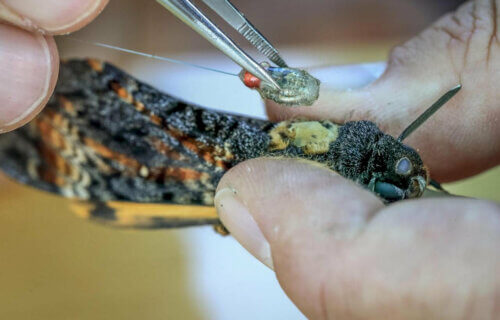MUNICH, Germany — A groundbreaking study that tracked insects for roughly 50 miles has discovered that these creatures use “sophisticated” navigation systems for long-distance migration.
Tiny trackers show that nocturnally migrating hawkmoths continually adjust their flight headings in response to winds and the landscape to keep their course straight and on target. Researchers in Germany say their study indicates that these moths use a sophisticated internal “map” or “compass” to guide them during their voyages. This is the longest scientists have continuously monitored a migrating insect.
Every year, trillions of migrating insects – including butterflies, locusts, and moths – travel vast distances across the globe on journeys that take them across continents, mountain ranges, oceans, and through a wide range of different environments.
With that in mind, the death’s-head hawkmoth travels up to 2,500 miles between Europe and sub-Saharan Africa. The new study, including scientists from the University of Exeter and the Max Planck Institute of Animal Behavior (MPI-AB), shows that they can maintain perfectly straight flightpaths even in windy conditions.
Insect migration is still a mystery
The research team radio tracked a group of migrating hawkmoths for roughly 50 miles. By closely following individual moths, the world-first study unlocked a century-old mystery of what insects do during these long journeys. The study, published in the journal Science, confirms that hawkmoths can accurately maintain straight trajectories over long distances.
Specifically, the findings confirm that insects are capable of accurate navigation, revealing that an internal compass guides them throughout the flight. Even though migrating insects far outnumber well-known migrants, such as birds, study authors say they actually know very little about their movements.
“Studying insects on the move is a formidable challenge,” says first author Myles Menz, who conducted the research at MPI-AB and is now a lecturer at James Cook University in Australia, in a media release. “They’re usually too numerous to mark and find again, and too small to carry tracking devices.”
Most of the knowledge scientists have about insect migration comes from studies observing sample insects at a single moment in time, such as through radar or direct observation.
“Understanding what insects do during migration, and how they respond to weather, is a last frontier in migration science,” says Menz.
Following moths on a European vacation
The study followed radio-tagged moths in a light aircraft, the first time scientists continuously followed nocturnal migrating insects in the wild. The team focused on the death’s-head hawkmoth which, like many insects, is a multi-generational migrant, meaning that no individual moth remembers the entire route on their own.
The researchers reared caterpillars until adulthood in a lab to ensure that the individuals were naïve. When the moths emerged as adults, study authors attached radio tags weighing 0.2 grams — less than 15 percent of an adults’ body weight.
“The moths would probably eat more weight than that in a night, so these tags are extremely light for the insects,” Menz continues.
The researchers then released the tagged moths and waited for flight to begin, after which they chose a single individual to follow for a time. Study authors followed 14 moths each for up to 50 miles or four hours. Researchers consider that distance long enough to be a migratory flight. They tracked the moths using antennas mounted on a Cessna airplane to detect precise locations every five to 15 minutes.
The insects traveled in the south-south-west direction from Konstanz into the Alps, which follows the route hawkmoths take towards the Mediterranean and northwest Africa. Due to practical constraints of flying in an aircraft, the scientists only tracked the moths until they stopped for rest.
“When you’re in an airplane, it becomes extremely difficult to wait for the insects to begin migrating again because you would have to be in the air when this happens, which could be anytime in the night,” says senior author Martin Wikelski, a movement ecologist from the MPI-AB and University of Konstanz, who piloted the plane during the study.
How do insects deal with the weather?
The results show that moths maintained perfectly straight trajectories for long distances during flight. The researchers add this was not because they waited for favorable tailwinds. Instead, they employed a range of flight strategies to protect against prevailing winds, allowing them to hold their course throughout the night.
When winds were favorable, the moths flew high and slow, allowing the air to carry them further. However, during harsh headwinds or cross winds, they flew lower to the ground and increased their speed to keep greater control over their path.
“For years it was assumed that insect migration was mostly about getting blown around. But we show that insects are capable of being great navigators, on par with birds, and are far less vulnerable to wind conditions than we thought,” Menz concludes.
“By showing that it is technically possible to continuously monitor individual insects over migration, and to observe their flight behavior in detail, we hope to inspire more studies to answer many more big questions in this area.”
The team notes that the next step is to answer the question of how moths are able to maintain such straight lines.
“Based on past lab work, it’s possible that the insects are using internal compasses, both visual and magnetic, to chart their way around the world.”
South West News Service writer Stephen Beech contributed to this report.
